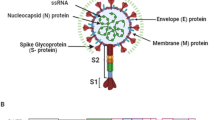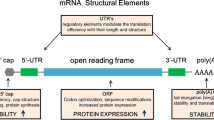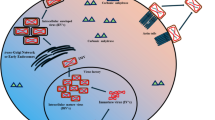Abstract
Entry of many viral and bacterial pathogens into host cells depends on cholesterol and/or cholesterol-enriched domains (lipid rafts) in the cell membrane. Earlier, we showed that influenza virus A matrix protein M1 contains amphipathic α-helices with exposed cholesterol-recognizing amino acid consensus (CRAC) motifs. In order to test possible functional activity of these motifs, we studied the effects of three synthetic peptides corresponding to the CRAC-containing α-helices of the viral M1 protein on the phagocytic activity of cultured mouse IC-21 macrophages. The following peptides were used: LEVLMEWLKTR (M1 α-helix 3, a.a. 39–49; further referred to as peptide 1), NNMDKAVKLYRKLK (M1 α-helix 6, a.a. 91–105; peptide 2), and GLKNDLLENLQAYQKR (M1 α-helix 13, a.a. 228–243; peptide 3). We found that all three peptides modulated interactions of IC-21 macrophages with non-opsonized 2-μm target particles. The greatest effect was demonstrated by peptide 2: in the presence of 35 μM peptide 2, the phagocytic index of IC-21 macrophages exceeded the control value by 60%; 10–11 mM methyl-β-cyclodextrin abolished this effect. Peptides 1 and 3 exerted weak inhibitory effect in a narrow concentration range of 5–10 μM. The dose-response curves could be approximated by a sum of two (stimulatory and inhibitory) components with different Hill coefficients, suggesting existence of at least two peptide-binding sites with different affinities on the cell surface. CD spectroscopy confirmed that the peptides exhibit structural flexibility in solutions. Altogether, our data indicate that amphipathic CRAC-containing peptides derived from the viral M1 protein modulate lipid raft-dependent processes in IC-21 macrophages.
Similar content being viewed by others
Change history
17 September 2018
On p. 982 in the list of authors instead of:
O. V. Bathishchev
Should read:
O. V. Batishchev
Abbreviations
- CD:
-
circular dichroism
- CRAC:
-
cholesterol-recognizing amino acid consensus
- mβCD:
-
methyl-β-cyclodextrin
- MM :
-
molecular mass
- TFE:
-
trifluoroethanol
References
Nayak, D. P., and Hui, E. K. (2004) The role of lipid microdomains in virus biology, Subcell. Biochem., 37, 443–491.
Carter, G. C., Bernstone, L., Sangani, D., Bee, J. W., Harder, T., and James, W. (2009) HIV entry in macrophages is dependent on intact lipid rafts, Virology, 386, 192–202.
Dou, X., Li, Y., Han, J., Zarlenga, D. S., Zhu, W., Ren, X., Dong, N., Li., X., and Li, G. (2018) Cholesterol of lipid rafts is a key determinant for entry and post–entry control of porcine rotavirus infection, BMC Vet. Res., 14, 45.
Lafont, F., and van der Goot, F. G. (2005) Bacterial invasion via lipid rafts, Cell. Microbiol., 7, 613–620.
Gatfield, J., and Pieters, J. (2000) Essential role for cholesterol in entry of mycobacteria into macrophages, Science, 288, 1647–1650.
Ouellet, H., Johnston, J. B., and Ortiz de Montellano, P. R. (2011) Cholesterol catabolism as a therapeutic target in Mycobacterium tuberculosis, Trends Microbiol., 19, 530–539.
Eggeling, C., Ringemann, C., Medda, R., Schwarzmann, G., Sandhoff, K., Polyakova, S., Belov, V. N., Hein, B., von Middendorff, C., Schonle, A., and Hell, S. W. (2009) Direct observation of the nanoscale dynamics of membrane lipids in a living cell, Nature, 457, 1159–1162.
Lingwood, D., and Simons, K. (2010) Lipid rafts as a membrane–organizing principle, Science, 327, 46–50.
Hanzal–Bayer, M. F., and Hancock, J. F. (2007) Lipid rafts and membrane traffic, FEBS Lett., 581, 2098–2104.
Sezgin, E., Levental, I., Mayor, S., and Eggeling, C. (2017) The mystery of membrane organization: composition, regulation and roles of lipid rafts, Nat. Rev. Mol. Cell Biol., 18, 361–374.
Li, H., and Papadopoulos, V. (1998) Peripheral–type ben–zodiazepine receptor function in cholesterol transport. Identification of a putative cholesterol recognition/interaction amino acid sequence and consensus pattern, Endocrinology, 139, 4991–4997.
Li, H., Yao, Z., Degenhardt, B., Teper, G., and Papadopoulos, V. (2001) Cholesterol binding at the cholesterol recognition/interaction amino acid consensus (CRAC) of the peripheral–type benzodiazepine receptor and inhibition of steroidogenesis by an HIV TAT–CRAC peptide, Proc. Natl. Acad. Sci. USA, 98, 1267–1272.
Epand, R. M. (2008) Proteins and cholesterol–rich domains, Biochim. Biophys. Acta, 1778, 1576–1582.
Epand, R. F., Thomas, A., Brasseur, R., Vishwanathan, S. A., Hunter, E., and Epand, R. M. (2006). Juxtamembrane protein segments that contribute to recruitment of cholesterol into domains, Biochemistry, 45, 6105–6114.
Schroeder, C. (2010). Cholesterol–binding viral proteins in virus entry and morphogenesis, in Subcellular Biochemistry: Cholesterol Binding and Cholesterol Transport Proteins, Springer, Vol. 51, pp. 77–108.
Tsfasman, T., Kost, V., Markushin, S., Lotte, V., Koptiaeva, I., Bogacheva, E., Baratova, L., and Radyukhin, V. (2015) Amphipathic alpha–helices and putative cholesterol binding domains of the influenza virus matrix M1 protein are crucial for virion structure organization, Virus Res., 210, 114–118.
Radyukhin, V. A., Dadinova, L. A., Orlov, I. A., and Baratova, L. A. (2018) Amphipathic secondary structure elements and putative cholesterol recognizing amino acid consensus (CRAC) motifs as governing factors of highly specific matrix protein interactions with raft–type membranes in enveloped viruses, J. Biomol. Str. Dynam., 36, 1351–1359.
Dunina–Barkovskaya, A. Ya., Karpunin, D. V., Lizunov, V. A., and Frolov, V. A. (2003) Macrophage cell line IC–21 as an experimental system for studies of electrophysiology of endocytosis, Biol. Membr. (Moscow), 20, 322–332.
Golovkina, M. S., Skachkov, I. V., Metelev, M. V., Kuzevanov, A. V., Vishniakova, Kh. S., Kireev, I. I., and Dunina–Barkovskaya, A. Ya. (2009) Serum–induced inhibition of the phagocytic activity of cultured macrophages IC–21, Biochemistry (Moscow) Suppl. Ser. A: Membrane Cell Biol., 4, 412–419.
Vishniakova, Kh. S., Kireev, I. I., and Dunina–Barkovskaya, A. Ya. (2011) Effects of cell culture density on phagocytosis parameters in IC–21 macrophages, Biochemistry (Moscow) Suppl. Ser. A: Membrane Cell Biol., 5, 355–363.
Dunina–Barkovskaya, A. Ya., Vishniakova, Kh. S., Cheshev, D. A., Chekanov, N. N., and Bujurina, I. M. (2007) Effects of DMSO and cholesterol–binding peptides on phagocytic activity of cultured macrophages IC–21, Biol. Membr. (Moscow), 24, 451–456.
Ueda, M. J., Ito, T., Ohnishi, S., and Okada, T. S. (1981) Phagocytosis by macrophages. I. Kinetics of adhesion between particles and phagocytes, J. Cell Sci., 51, 173–188.
Dunina–Barkovskaya, A. Ya. (2004) Phagocytosis–three in one: endocytosis, exocytosis, adhesion, Biol. Membr. (Moscow), 21, 245–272.
Iesmantavicius, V., Dogan, J., Jemth, P., Teilum, K., and Kjaergaard, M. (2014) Helical propensity of an intrinsically disordered protein accelerates ligand binding, Angew. Chem. Int., 53, 1548–1551.
Eiriksdottir, E., Konate, K., Langel, U., Divita, G., and Deshayes, S. (2010) Secondary structure of cell–penetrating peptides controls membrane interaction and insertion, Biochim. Biophys. Acta, 1798, 1119–1128.
Medina, S. H., Miller, S. E., Keim, A. I., Gorka, A. P., Schnermann, M. J., and Schneider, J. P. (2016) An intrin–sically disordered peptide facilitates non–endosomal cell entry, Angew. Chem. Int., 55, 3369–3372.
Di Veroli, G. Y., Fornari, C., Goldlust, I., Mills, G., Koh, S. B., Bramhall, J. L., Richards, F. M., and Jodrell, D. I. (2015) An automated fitting procedure and software for dose–response curves with multiphasic features, Sci. Reports, 5, 14701.
Pike, L. J., and Miller, J. M. (1998) Cholesterol depletion delocalizes phosphatidylinositol bisphosphate and inhibits hormone–stimulated phosphatidylinositol turnover, J. Biol. Chem., 273, 22298–22304.
Zidovetzki, R., and Levitan, I. (2007) Use of cyclodextrins to manipulate plasma membrane cholesterol content: evi–dence, misconceptions and control strategies, Biochim. Biophys. Acta, 1768, 1311–1324.
Peyron, P., Bordier, C., N’Diaye, E.–N., and Maridonneau–Parini, I. (2000) Nonopsonic phagocytosis of Mycobacterium kansasii by human neutrophils depends on cholesterol and is mediated by CR3 associated with gly–cosylphosphatidylinositol–anchored proteins, J. Immunol., 165, 5186–5191.
Oh, H., Mohler, E. R., Tian, A., Baumgart, T., and Diamond, S. L. (2009) Membrane cholesterol is a biomechanical regulator of neutrophil adhesion, Arterioscler. Thromb. Vasc. Biol., 29, 1290–1297.
Viswanathan, G., Jafurulla, M., Kumar, G. A., Raghunand, T. R., and Chattopadhyay, A. (2015) Dissecting the membrane cholesterol requirement for mycobacterial entry into host cells, Chem. Phys. Lipids, 189, 19–27.
De Planque, M. R. R., and Killian, J. A. (2003) Protein–lipid interaction studied with designed transmembrane peptides: role of hydrophobic matching and interfacial anchoring, Mol. Membr. Biol., 20, 271–284.
Hanson, J. M., Gettel, D. L., Tabaei, S. R., Jackman, J., Kim, M. Ch., Sasaki, D. Y., Groves, J. T., Liedberg, B., Cho, N.–J., and Parikh, A. N. (2016) Cholesterol–enriched domain formation induced by viral–encoded, membrane–active amphipathic peptide, Biophys. J., 110, 176–187.
Dunina–Barkovskaya, A. (2012) Cholesterol–binding peptides and phagocytosis, in Protein Interactions (Cai,J., and Wang, R. E., eds.), IntechOpen, Croatia, pp. 275–290.
Miller, C. M., Brown, A. C., and Mittal, J. (2014) Disorder in cholesterol–binding functionality of CRAC peptides: a molecular dynamics study, J. Phys. Chem. B, 118, 13169–13174.
Febbraio, M., Hajjar, D. P., and Silverstein, R. L. (2001) CD36: a class B scavenger receptor involved in angiogenesis, atherosclerosis, inflammation, and lipid metabolism, J. Clin. Invest., 108, 785–791.
Han, J., Hajjar, D. P., Tauras, J. M., and Nicholson, A. C. (1999) Cellular cholesterol regulates expression of the macrophage type B scavenger receptor, CD36, J. Lipid Res., 40, 830–838.
Epand, R. M., Sayer, B. G., and Epand, R. F. (2003) Peptide–induced formation of cholesterol–rich domains, Biochemistry, 42, 14677–14689.
Rog, T., and Vattulainen, I. (2014) Cholesterol, sphingolipids, and glycolipids: what do we know about their role in raft–like membranes? Chem. Phys. Lipids, 184C, 82–104.
Yang, G., Xu, H., Li, Z., and Li, F. (2014) Interactions of caveolin–1 scaffolding and intramembrane regions containing a CRAC motif with cholesterol in lipid bilayers, Biochim. Biophys. Acta, 1838, 2588–2599.
Cheng, G., Montero, A., Gastaminza, P., Whitten–Bauer, C., Wieland, S. F., Isogawa, M., Fredericksen, B., Selvarajah, S., Gallay, P. A., Ghadiri, M. R., and Chisari, F. V. (2008) A virocidal amphipathic α–helical peptide that inhibits hepatitis C virus infection in vitro, Proc. Natl. Acad. Sci. USA, 105, 3088–3093.
Pae, J., and Pooga, M. (2014) Peptide–mediated delivery: an overview of pathways for efficient internalization, Ther. Deliv., 5, 1203–1222.
Author information
Authors and Affiliations
Corresponding authors
Additional information
Published in Russian in Biokhimiya, 2018, Vol. 83, No. 8, pp. 1235–1246.
Rights and permissions
About this article
Cite this article
Dunina-Barkovskaya, A.Y., Vishnyakova, K.S., Golovko, A.O. et al. Amphipathic CRAC-Containing Peptides Derived from the Influenza Virus A M1 Protein Modulate Cholesterol-Dependent Activity of Cultured IC-21 Macrophages. Biochemistry Moscow 83, 982–991 (2018). https://doi.org/10.1134/S0006297918080096
Received:
Revised:
Published:
Issue Date:
DOI: https://doi.org/10.1134/S0006297918080096




